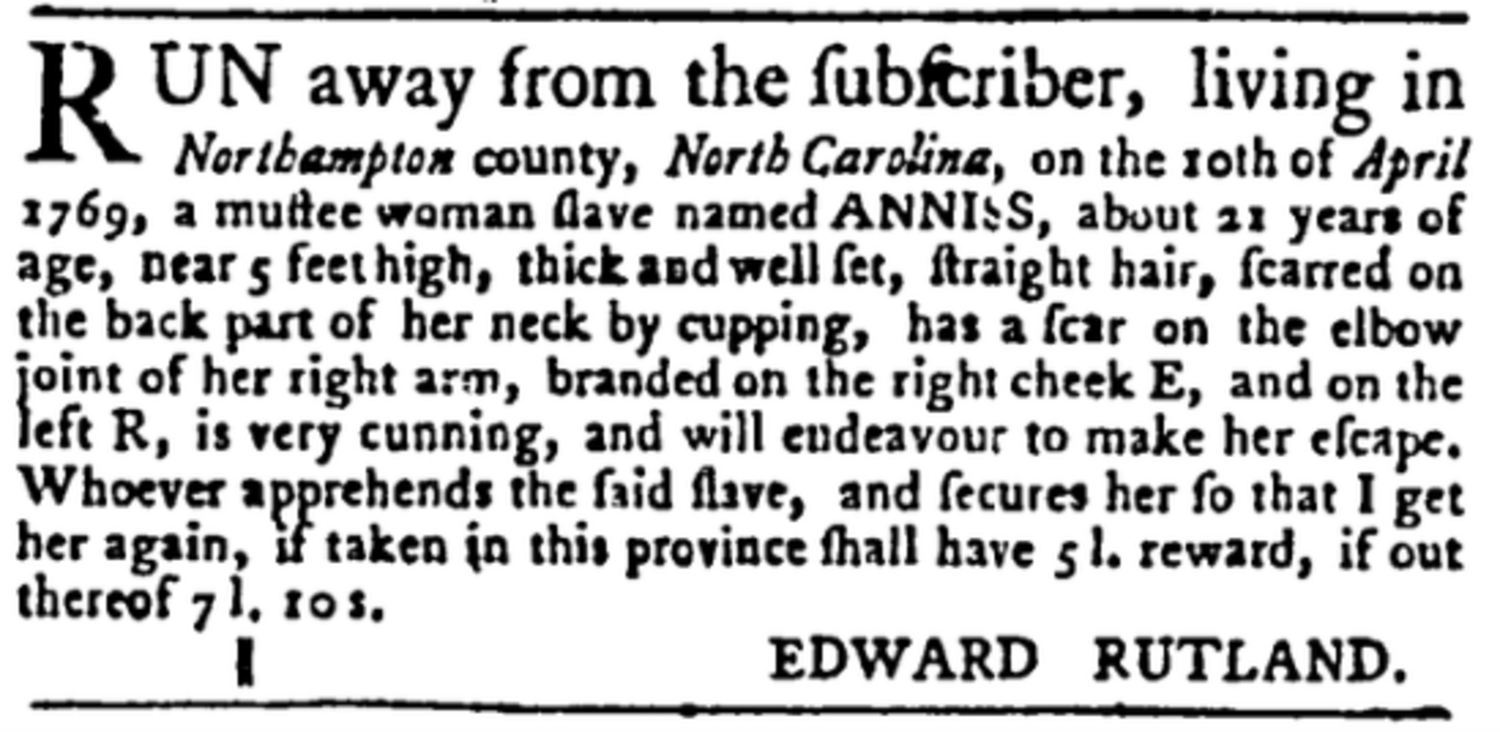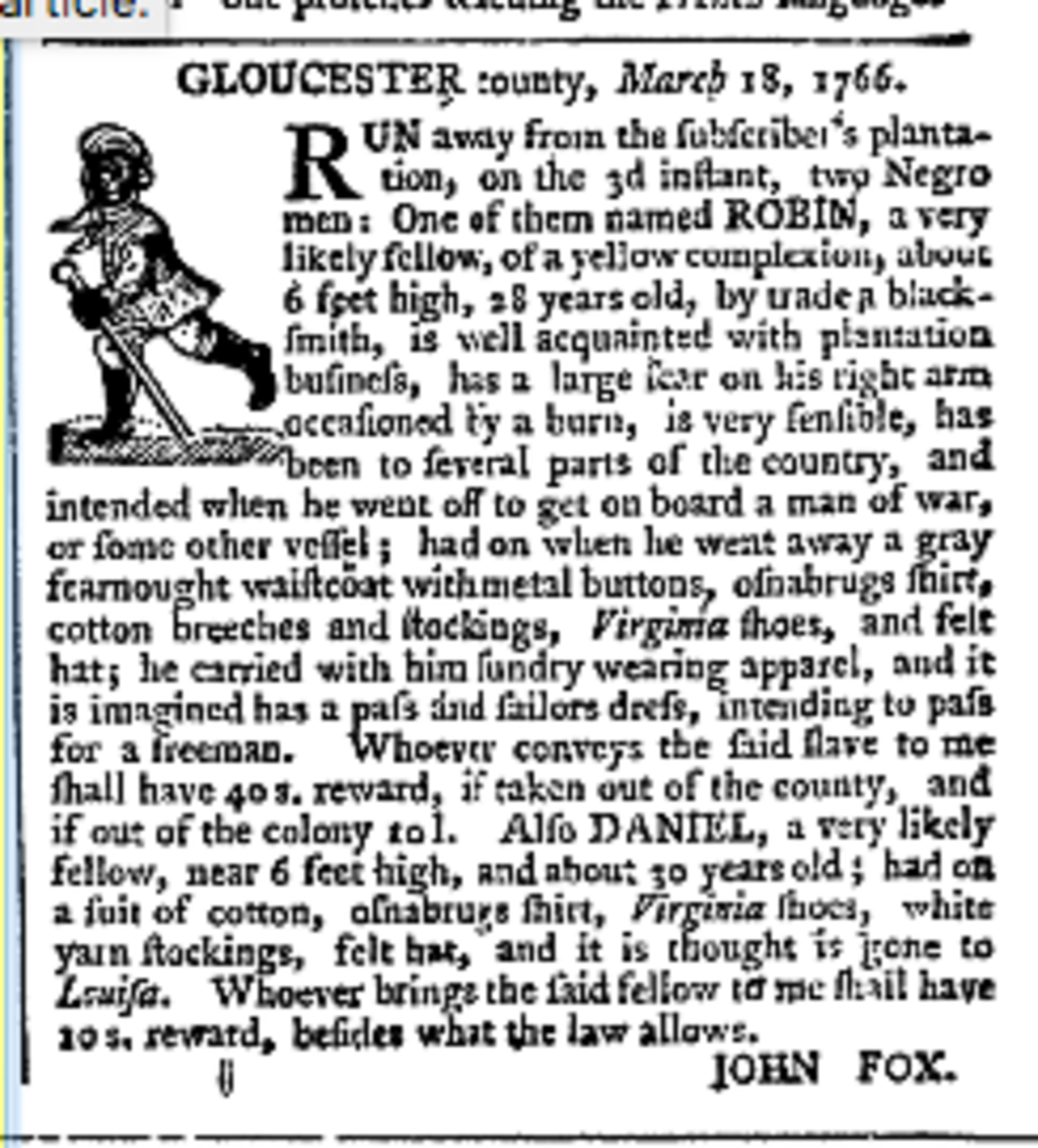62 Runaways (1741-9)
These extracts from contemporary newspapers show the frequency of escapes of indentured white servants and slaves, and throw some light on the brutality of the whole system.

Run away from Marten Ryerson of Readingtown in the County of Hunterdon, a young servant man named William Hains. Small stature, ruddy complexion, big nose, big blue eyes, pock-broken, had no hair, branded on the brawn of his thumb of the left hand. Had on when he run away a white shirt and a sailor’s frock [coat], a pair of trousers; but has since got a greek vestment. It’s probable that he has changed his name, for he has already passed by the name of Thomson and Robinson. Whoever takes up the said servant and secures him so that his said master may have him again shall have five pounds reward besides all reasonable charges paid by Marten Ryerson — The New-York Weekly Journal, June 15. 1741.
Deserted from His Majesty’s Service out of the American Regiment of Foot, commanded by Col. William Gooch, and lately enlisted in West-Jersey, by Lieutenant Anthony Palmer . . . Thomas Fury, a laborer, born in the north of Ireland, about 21 years of Age, 5 Foot 10 Inches high, well-set, fair complexioned, with very fair eye brows, grey eyes, and much pockfretten [smallpox scars]. Had on when he went away, a greyish homespun coat with brass buttons, the lower-most but one having the top broke off and in other places some off. Linen trousers and a pair of new shoes. He worked some time since as a laborer in Maryland and in Chester County, but lately in Trenton. Whoever secures the said deserters so as their officer may have them again shall receive three pounds reward for each and all reasonable charges. Or if anyone will inform the said officer, by whom either of them are concealed, so that it may be proved, shall receive five pounds sterling for each of them . . . N. B. If either of the said deserters will return, they shall be kindly received by their officer and not prosecuted. — The Pennsylvania Gazette July 22, 1742.
There was lately committed to the Gaol [jail] of Sussex County, upon Delaware, two men, suspected to be servants, viz. John Williams, a west-countryman aged about 32 years, says he came into the western part of Virginia with one Capt. Taylor from Bristol. He is a lusty man, wears his own hair, ozenbrigs [coarse linen] shirt, yarn stockings, old brown coat very much patched, an old felt hat, leather breeches, white homespun twiled [twill] jacket, metal buttons of several sorts upon all his clothing. And Thomas Rogers . . . They say they came in freemen. The owners (if any they have) are desired to come or send for them in one month’s time after this date, otherwise they will be discharged paying their fees. Peter Hall, Sheriff. Lewistown, March 9, 1742. — The Pennsylvania Gazette
Run away on the 3d of August from Benjamin Thomson of Cohansie, the two following servants, viz. One John Hacket, this Country-born, short and thick, aged about 28 years. Had on an old felt hat, two shirts, one tow the other ozenbrigs, old patched jacket, lightish colored great coat, ozenbrigs trousers, good shoes, and a pair of shoe-packs. The other named Richard Lane, this country-born. . . . Whoever secures the said servants so that their master may have them again, shall have four pounds reward and reasonable charges, paid by Benjamin Thompson. N. B. They took with them two guns, one long the other short, and a middle sized dog that goes by the name of gunner and when he’s traveling paces. — The Pennsylvania Gazette, Sept. 8, 1743.
Trenton, March 25, 1745. Taken up, about 6 months ago as a runaway, and now is in Trenton Gaol, one John Parra, a well set fellow about 24 years of age and pretends to know something of the hatter’s trade. If no person claims him before the first day of May next, he will be sold for defraying his charges. By order of the Court. William Brown, Under Sheriff. — The Pennsylvania Gazette, April 4, 1745.
Run away the 24th of last month from Bennet Bard of Burlington, a mulatto Spanish slave named George, aged about 24 years, about 5 Feet 10 inches high, smooth-faced, well-set, and has his hair lately cut off. Speaks tolerable good English, born at the Havana, says he was several years with Don Blass and is a good shoemaker. Had on when he went away a corded dimity [sheer cotton] waistcoast [vest], ozenbrigs shirt and trousers, no stockings, old shoes, and a new hat. Whoever takes up and secures said fellow so that his master may have him again shall have forty shillings reward and reasonable charges, paid by Bennet Bard. — The Pennsylvania Gazette, August 1, 1745.
Broke out of Trenton Gaol on Saturday night last, one James Johnston, a lusty, strong built man about six foot high, of a fresh complexion and fair insinuating speech. He is an Irishman and his right name is White. He lately ran from his bail and entered on board the dreadnought, Capt. Cunningham, who upon application caused him to be set on shore at Newcastle and committed to gaol there, from whence he was brought last Thursday. Whoever shall apprehend the said Johnston and secure him shall have five pounds proclamation money as a reward. William Brown, Under Sheriff. — The Pennsylvania Gazette Nov. 7, 1745.
 Philadelphia, April 14. 1748. Run away from Samuel Lippincott of Northampton in the county of Burlington, an Irish servant maid named Mary Muckleroy, of a middle stature. Had on when she went away, a blue and white striped gown of large and small stripes, cuffed with blue, a white muslin handkerchief, an old blue quilt, a new Persian black bonnet, a new pair of calf-skin shoes, a fine Holland cap with a cambrick border, an old black short cloak lined with Bengal, blue worsted stockings with white clocks, a very good fine shirt, and a very good white apron. She took with her a sorrel horse, about 14 hands high, shod before and paces very well. It is supposed there is an Irishman gone with her. Whoever takes up and secures the said woman and horse so that they may be had again shall have three pounds reward and reasonable charges paid by Samuel Lippincott. — The Pennsylvania Gazette April 16, 1748.
Philadelphia, April 14. 1748. Run away from Samuel Lippincott of Northampton in the county of Burlington, an Irish servant maid named Mary Muckleroy, of a middle stature. Had on when she went away, a blue and white striped gown of large and small stripes, cuffed with blue, a white muslin handkerchief, an old blue quilt, a new Persian black bonnet, a new pair of calf-skin shoes, a fine Holland cap with a cambrick border, an old black short cloak lined with Bengal, blue worsted stockings with white clocks, a very good fine shirt, and a very good white apron. She took with her a sorrel horse, about 14 hands high, shod before and paces very well. It is supposed there is an Irishman gone with her. Whoever takes up and secures the said woman and horse so that they may be had again shall have three pounds reward and reasonable charges paid by Samuel Lippincott. — The Pennsylvania Gazette April 16, 1748.
Philadelphia, June 8. 1749. Run away from Nicholas Bearcraft of Hunterdon County, a black wench named Hecatissa alias Savina. Country born, about 27 years of age, short stature, gloomy down look, often troubled with the cholic. It is thought she may be gone towards Maryland. Whoever takes up and secures said wench so that she may be had again shall have twenty shillings reward and reasonable charges, paid by Nicholas Bearcraft. — The Pennsylvania Journal, June 8, 1 749.
Run away the 7th of this instant July, from Matthew Forsyth of Chesterfield, Burlington county, an apprentice lad named Elisha Bullingham, by trade a house-carpenter, about 16 years of age. Had on, or took with him, a half worn felt hat, old brown drugget [coarse fabric] coat, one pair leather breeches, two ozenbrigs shirts, and two pair of ozenbrigs trousers. His hair is newly cut off and he has his indentures with him. Whoever takes up and secures said apprentice so that his master may have him again shall have forty shillings reward and reasonable charges, paid by me, Matthew Forsyth N. B. He is supposed to be going towards New-England; wherefore all masters of vessels, or others, are forbid to carry him off at their peril. — The Pennsylvania Gazette July 13, 1749.
Philadelphia, February 6, 1749. Whereas Margaret Simkins, wife of Daniel Simkins of Stow creek, in the county of Cumberland and province of West-Jersey, has and does elope from time to time from her said husband, to his great damage; these are to forewarn all persons from trusting said Margaret on his account, for he will pay no debts of her contracting from the date hereof. Daniel Simkins. — The Pennsylvania Gazette Feb. 6, 1749.
Source: “All Sorts of Runaways (1741-1750)” in William Nelson, editor, Documents relating to the Colonial History of the State of New Jersey (Paterson, 1895), Xli, 95-600. https://archive.org/details/in.ernet.dli.2015.45494/page/n321/mode/2up
